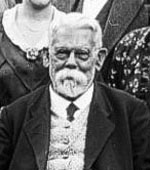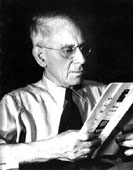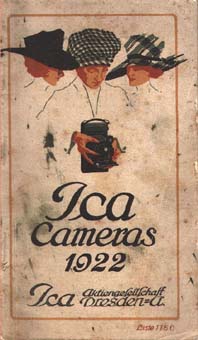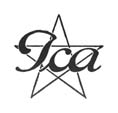
Ica AG – founded 100 years ago
by
Klaus-Eckard Riess
“Ica” is a word which I have been familiar with since my earliest childhood. It was the Zeiss Ikon Ica-Werk where my father went to work. Since the factory was bombed to pieces in February 1945, my father’s office was also destroyed. It made me, a six year old kid, weep over my loss. Out of a medicine box I had cut and pasted together a little coach with horses in front, which my father had placed on his desk. The bombing that night destroyed my modest art, along with most of the company.
Throughout my boyhood and my apprenticeship I often passed the old Ica-Werk on Schandauer Strasse in Dresden-Striesen, either on foot, by bicycle or tram. What the letters “Ica” stood for, I then knew nothing about.
“International Camera A.G.” was formed on the 7th of October 1909 by an amalgamation of four different camera factories:
Richard Hüttig & Sohn, Emil Wünsche, Dr. R. Krügener and Carl Zeiss Palmos. Three years later G. Zulauf & Co. from Zurich was added to the firm. Heinrich Ernemann in Dresden also participated in the negotiations, but he declined to join at the last minute because he would not give up sovereignty over his efficient company.
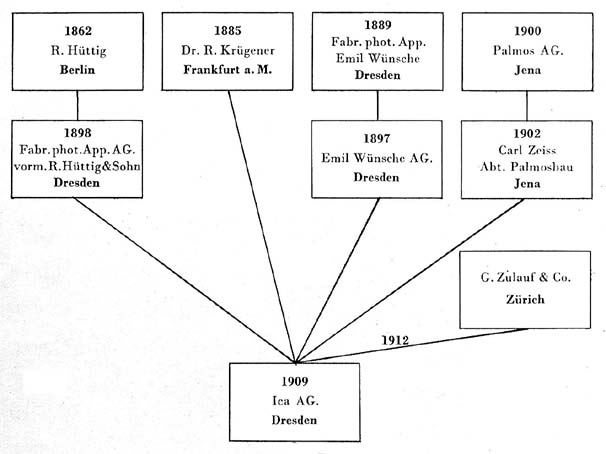
As is well known, I am able to produce perfect Daguerreotypes. From now on I will be selling plates of the same kind that I use, in the sizes: 3 inches, 4 inches, 6 inches, etc. I am also producing cameras, not only in accordance with Daguerre’s instructions but also in accordance with mine, resulting in an apparatus that has only 1/20 the volume of Daguerre’s.
Enzmann, mechanic
Annen Gasse No. 8
What this mini-version of Daguerre’s camera looked like and how many copies were manufactured, no one can say today. Yet Friedrich W.Enzmann is remembered today as the first who produced cameras in Dresden. Ica AG, as well as its later successor Zeiss Ikon AG, identified 1862 as the year of the company’s origin. In this year Richard Hüttig from Silesia founded a workshop for making wooden cameras in Berlin. In 1887 Hüttig moved his business to Saxony’s capital Dresden, probably because the production of photographic paper there had begun to give Dresden a reputation as a center of photographic activity. Hüttig‘s success with innovative camera models permitted him in 1897 to raise a large factory building and residential houses for company employees. This building on Schandauer-Straße 76 in Dresden later became the Zeiss Ikon Ica-Werk and the headquarters of Zeiss-Ikon, and later, in the years of the GDR, finally contained the VEB Pentacon directors. Unfortunately, and to the great regret of many people with a consciousness of photographic history, this building was demolished in 1997. Richard Hüttig’s greatest photo-historic achievement was that in 1896 he introduced the “Zeus-Spiegel-Camera”, the first SLR camera in Dresden. This camera was followed up one year later by the “Reflex Camera”, which was equipped with both focal-plane shutter, bellows and interchangeable lens.
Hüttig’s company evolved into Europe’s largest camera works with over 800 employees. The top of the company’s range must have been the “Künstler-Camera” from 1905, a SLR camera which was supplied in 8 different format sizes from 6×9 to 13×18 cm. The camera was fitted with an ingenious device which automatically rotated a mask on the ground glass into the correct position when you turned the cassette from landscape to portrait orientation.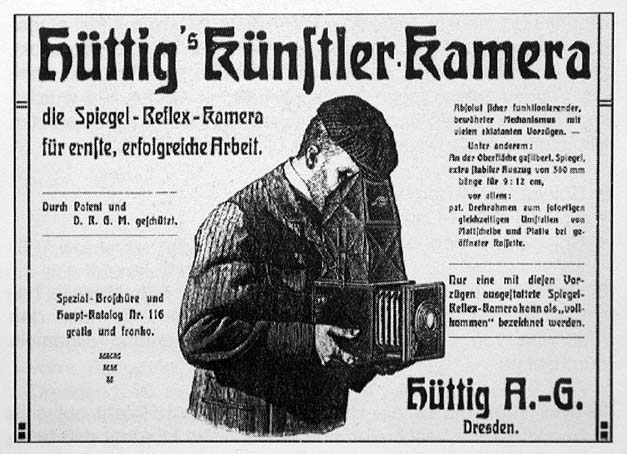
Dictum: “High-flying, deep fall” also fits the next name that was on its way to the big merger in 1909. Emil Wünsche founded in 1887 a camera store at Moritz Strasse 20 in Dresden, where he partly through mail order sold all kinds of photographic supplies. Eventually he initiated his own camera production, and in 1897 he built a large factory near Reick, at that time a village outside of Dresden. A novel feature at the factory was a large steam engine to supply energy. He also provided housing for factory officials as Richard Hüttig had done. The factory building still stands today. After being the manufacturing site of Emil Wünsche, ICA, Zeiss Ikon and finally Pentacon, it now houses a modern training center. Here in the VEB Zeiss Ikon Werk Reick I did work as an apprentice from 1953 to 1956.
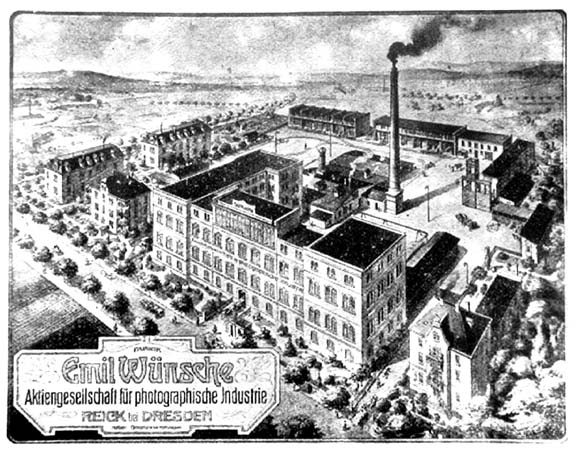
In the period 1897 to 1909, more than 400 different models of Wünsche cameras were produced, and these could again be divided into numerous variants in terms of formats, shutters and lenses. As in the case of Hüttig, so much variety was finally too unmanageable and uneconomical. Besides the nice magazine camera “Mars” were camera names like “Bosco”, “Ada”, “Afpi”, “Kolibri”, “Vitrix”, “Excelsior Syrene”, “Nymphe”, “Nixe”, “Lola”, “Knox”, etc. In 1902 Emil Wünsche took his own life because of personal and financial problems. His companion Louis Lang led the company forward in Wünsche’s spirit. The competitive crisis in the photographic industry was so acute that the only resolution seemed to lie in the ongoing negotiations to form a large association of camera factories in Dresden. Wünsche’s photo shop in Dresden’s city center was not affected by the merger. It actually continued in existence right up to the destruction of Dresden by bombs on the night of 13th February 1945. Carl Zeiss Jena began to manufacture camera lenses around 1890, and so this firm was concerned about the problems facing their customers, the camera factories of Dresden. Carl Zeiss wanted to continue selling their lenses and they also had interests in the shutter manufacturers Deckel and Gauthier. To break into the camera-manufacturing industry, Carl Zeiss Jena had in 1900 initiated a collaboration with Curt Bentzin in Görlitz, which resulted in 1902 in the formation of “Palmos Camerabau” in Jena. Palmos produced a number of excellent cameras, such as the “Minimum-Palmos”. Palmos Camerabau was Carl Zeiss Jena’s contribution to the merger.
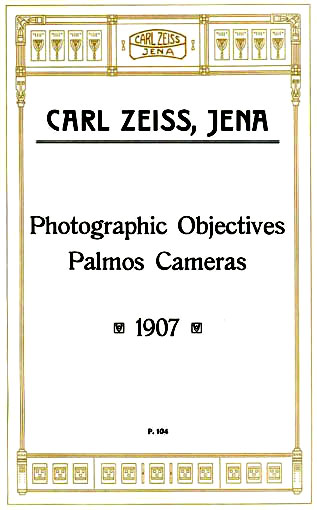
The fourth player in solitaire on Ica AG was Dr. Rudolph Krügener from Bockenheim at Frankfurt am Main. Dr. Krügener had originally been a chemist, but when he lost a leg in an awful explosion, he demonstrated his skill and ingenuity by designing a prosthesis for himself. He began his camera production in 1888 and achieved his first great success with a camera designed as a fine old book: “Dr. Krügeners Taschenbuch-Camera”. The camera had a negative format of 4×4 cm, it could hold 24 photo plates in its magazine and it was equipped with a guillotine shutter. Krügener next produced a real milestone in camera history with the 1889 introduction of his “Simplex Magazine-camera”. This camera can in good conscience be described as a prototype of the twin-lens mirror-reflex camera. The camera was equipped with a rotating shutter and two magazines. The top magazine was able to hold 24 negative plates of the format 6×8 cm. After the plates were exposed in the recording chamber behind the lens and shutter, they were shifted to the stack of plates in the lower magazine.

Heinrich Ernemann was until the very end one of the most active participants in the preparations for the big merger in 1909. But when it dawned on him that he would not get the influential position he felt he deserved, he pulled himself out of the cooperation at the very last minute.
The capital of the 4 participating companies was devalued by 25 % so the total capital of the new company Ica AG became divided as follows:
- Carl Zeiss Palmos 650.000 Mark
- former shareholders of Hüttig 786.000 Mark
- former shareholders of Wünsche 400.000 Mark
- former shareholders of Dr. Krügener 400.000 Mark
- Deutsche Bank 664.000 Mark
The Carl Zeiss Foundation immediately took over the stock of 650.000 Mark of the new Ica-shares, and the Foundation further increased its amount of shares until it achieved the majority and became the leading party in Ica AG.
“International Camera A.G.” or Ica AG became a reality on the 7th of October 1909. Hüttig’s former director Guido Mengel was Ica AG’s powerful leader. The company’s headquarters address was in Hüttig’s building Schandauer Strasse 76, and also the Hüttig firm’s five-pointed star (the so-called Pentagram) was taken over as the logo of the newly formed company.
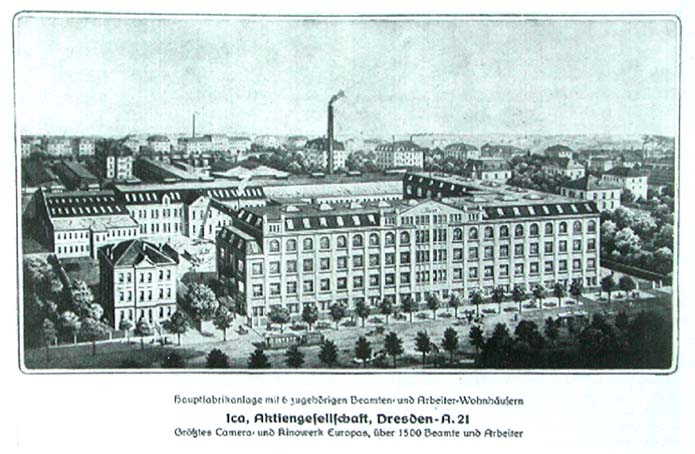
With the formation of the merged Ica AG, a simplification and reduction of the giant range of similar camera models became feasible. A somewhat disappointing first step was the closure of Wünsche’s factory at Reick. However, production was resumed at Reick in the following year. Ica catalogs from the years following the merger show that the reduction of redundant camera models was only partially successful. Many of the predecessor firm’s camera names are repeated. The number of plate cameras is still almost incomprehensible, but a growing number of Icarette cameras testify
that roll film is gaining ground. Professional photographers were offered the bulky “Tudor Spiegelreflex-Camera” or “Künstler-Spiegelreflex-Camera”, weighing up to 3.5 kg. But the photographer who wanted a camera which was a bit more portable could get the collapsible “Klappreflex-Künstler-Camera”.
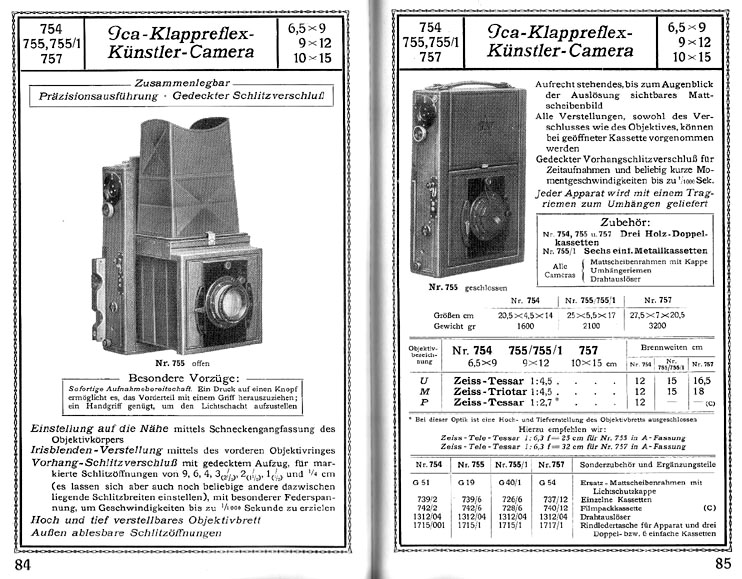
In June 1917, near the middle of the First World War, the leadership at Carl Zeiss retrieved the Russian-born, brilliant scientist and inventor Emanuel Goldberg from a professorship in Leipzig for a post at Ica AG in Dresden. Over time, Goldberg was positioned to be Mengel’s future successor.
|
|
|
Emanuel Goldberg was not only a brilliant chemist and physicist, he was also an incredibly ingenious mechanic. In 1921 he constructed the relatively small 35mm movie camera, “Ica-Kinamo” which could be supplied in 2 versions: for 15m or 20m film cassette. Two years later, he invented a spring-motor drive that could be linked to the camera to improve the convenience of operation. To show what this sensational camera was good for, Emanuel Goldberg produced a series of short films with himself, his wife Sophie and their children in leading roles.
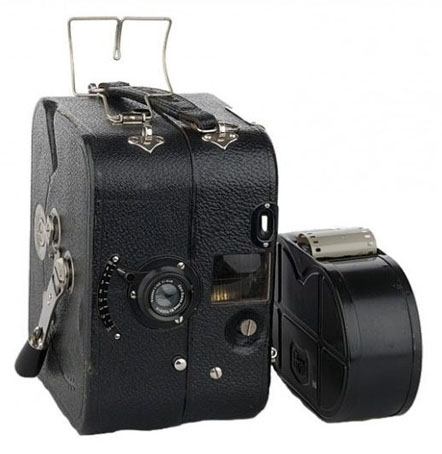
In the mid-twenties the stage was set for the next big merger in the camera industry. By 1920, there was a community of interest between Ica AG in Dresden and Contessa-Nettel in Stuttgart, or to put it more bluntly: by 1920, Carl Zeiss, the most powerful faction within Ica, had Contessa-Nettel in its pocket. All that was lacking to make the coup complete were the two main competitors: Heinrich Ernemann in Dresden and CP Goerz in Berlin. Long, tough and complex negotiations, in which Emanuel Goldberg from Ica AG played a prominent role, led eventually to the formation of Zeiss Ikon AG. Richard Hüttig’s old building at Schandauer Strasse 76 in Dresden-Striesen was chosen to be the home of the executive and administration functions. Professor Goldberg, as Director General of the newly formed company, now had to undertake a major review of product rationalization and industrial restructuring. The start of the firm Zeiss Ikon AG on the 1th of October 1926 ended the story of the Ica AG, which had its beginning on the 7th of October 1909.
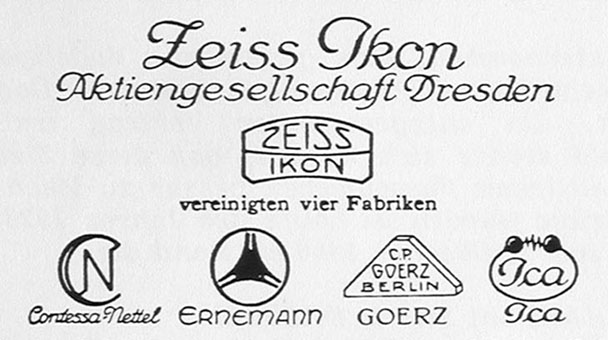
Literature:
Herbert Blumtritt “Geschichte der Dresdner Foto-Industrie”
Richard Hummel “Spiegelreflexkameras aus Dresden”
Zeiss Ikon AG “Festschrift – 75 Jahre
Photo-und Kinotechnik”
Thanks to Robert Stoddard for kind assistance
Find related cameras from other predecessors of the Zeiss Ikon AG at next (gernan) submenu or click on the catalogue and find related cameras from other predecessors of the Zeiss Ikon AG

